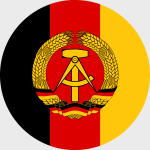Panzerkampf PZK14643PB East German Mikoyan Gurevich MiG-19PM "Farmer-E" Fighter - "Red 335", Militarhistorisches Museum der Bundeswehr, Flugplatz Berlin-Gatow, Germany (1:72 Scale)
"Were the Soviet Union to sink tomorrow under the waters of the ocean, the American military-industrial establishment would have to go on, substantially unchanged, until some other adversary could be invented. Anything else would be an unacceptable shock to the American economy."
- George Frost Kennan, American advisor, diplomat, political scientist, and historian, best known as "the father of containment" and as a key figure in the emergence of the Cold War
 The Mikoyan-Gurevich MiG-19 NATO reporting name: Farmer) is a Soviet second generation, single-seat, twinjet fighter aircraft, the world's first mass-produced supersonic aircraft. It was the first Soviet production aircraft capable of supersonic speeds in level flight. A comparable U.S. "Century Series" fighter was the North American F-100 Super Sabre, although the MiG-19 primarily fought against the more modern McDonnell Douglas F-4 Phantom II and Republic F-105 Thunderchief over North Vietnam.
The Mikoyan-Gurevich MiG-19 NATO reporting name: Farmer) is a Soviet second generation, single-seat, twinjet fighter aircraft, the world's first mass-produced supersonic aircraft. It was the first Soviet production aircraft capable of supersonic speeds in level flight. A comparable U.S. "Century Series" fighter was the North American F-100 Super Sabre, although the MiG-19 primarily fought against the more modern McDonnell Douglas F-4 Phantom II and Republic F-105 Thunderchief over North Vietnam.
Deliveries of the new fighter to the Soviet Air Forces (VVS) began in June 1955, with the type being publicly unveiled on 3 July that year, when 48 MiG-19s took part in a flypast during an airshow at Tushino Airfield, Moscow.
During their service with Soviet Anti-Air Defense and in East Germany, MiG-19s were involved in multiple interceptions of Western reconnaissance aircraft. The first documented encounter with a Lockheed U-2 took place in the autumn of 1957. The MiG-19 pilot reported seeing the aircraft, but could not make up the 3,000 m (9,800 ft) difference in altitude. When Francis Gary Powers's U-2 was shot down in the 1960 incident, one pursuing MiG-19P was also hit by the salvo of S-75 Dvina (NATO: SA-2 "Guideline") missiles, killing the pilot Sergei Safronov. In a highly controversial incident, on July 1st, 1960, a MiG-19 shot down an RB-47H (S/N 53-4281) reconnaissance aircraft in international airspace over the Arctic Circle with four of the crew killed and two captured by the Soviets (they were released in 1961). In another incident, on January 28th, 1964, a MiG-19 shot down a T-39 Sabreliner which had strayed into East German airspace while on a training mission; all three crewmembers were killed.
Pictured here is a 1:72 scale replica of an East German Mikoyan Gurevich MiG-19PM "Farmer-E" fighter that is currently on display at the Militarhistorisches Museum der Bundeswehr, located at Flugplatz Berlin-Gatow, Germany.
Pre-order! Ship Date: March 2025.
Dimensions:
Wingspan: 5-1/4-inches
Length: 6-1/4-inches
Release Date: ?
Historical Account: "Museum Piece" - The Militarhistorisches Museum der Bundeswehr - Flugplatz Berlin-Gatow (Bundeswehr Museum of Military History - Berlin-Gatow Airfield; formally known as Luftwaffenmuseum der Bundeswehr), is the Berlin branch of the Bundeswehr Military History Museum. The museum acts as an independent military department.
The museum is in Berlin at a former Luftwaffe and Royal Air Force (RAF) airfield, RAF Gatow. The focus is on military history, particularly the history of the post-war German Air Force. The museum has a collection of more than 200,000 items, including 155 airplanes, 5,000 uniforms and 30,000 books. There are also displays (including airplanes) on the history of the airfield when it was used by the RAF.
Aircraft include World War I planes such as the Fokker E.III as reproductions, and World War II planes such as the Bf 109, as well as at least one aircraft of every type ever to serve in the air forces of East and West Germany. Most of those postwar aircraft are stored outside on the tarmac and runways, however, and many are in bad condition. There are long term restoration projects, including a Focke-Wulf Fw 190. Because of that the museum is under construction, some exhibits are shortly removed for restoration, repainting or lending to other museums.







![Star Trek Klingon D7 Battle Cruiser [With Collector Magazine]](http://cdn4.volusion.store/qh9e9-jdqv9/v/vspfiles/photos/EMST0067-1.jpg?v-cache=1740197136)
